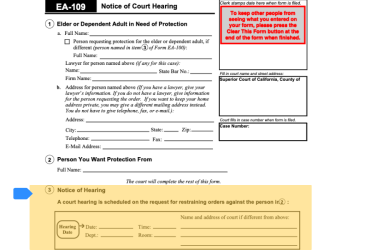What do these papers mean?
Elder or Dependent Adult Abuse Restraining Orders (EA-109, EA-100, EA-110)
If you received any of these forms, someone asked for a restraining order against you:
- Notice of Court Hearing (form EA-109)
- Request for Elder or Dependent Adult Abuse Restraining Orders (form EA-100)
- Temporary Restraining Order (form EA-110)
A restraining order would limit your contact with the elder or dependent adult named in the request. A restraining order could also impact your life in other ways, including preventing you from having guns and ammunition.
You have a court date where a judge will decide if they will grant the restraining order, which can last up to 5 years.
If you received a Temporary Restraining Order (form EA-110), the judge made temporary orders against you that will last until your court date. Look through the form carefully and follow all the orders.

When do I go to court?
Notice of Court Hearing (form EA-109)
This form tells you when you need to go to court. You have a court hearing (court date) because the person listed in number 1 has asked for a restraining order against you. If you do not agree to have a restraining order against you, you must go to court on your hearing date to tell the judge why you do not agree.
Look at number 3 on this form to see the date, time, and location for your court hearing.
What is the other side asking for?
Request for Elder or Dependent Adult Abuse Restraining Orders (form EA-100)
On form EA-100, the other side checked every order they want the judge to make (items 11-21). If you disagree with any of the orders the other side asked for, you must go to your court date to tell the judge why you do not agree. You may also tell the court in writing before the hearing date.
Has the judge made any temporary orders against me?
Temporary Restraining Order (form EA-110)
This form tells you that the judge made temporary orders against you. Look through it carefully and follow all the orders. If you violate any of the orders you could be arrested, be sent to jail, or be charged with a crime. If you own any guns or ammunition, see below under "Do I need to complete any papers?" for what you need to do to comply with the judge's orders.
Do I need to complete any papers?
If there's a Temporary Restraining Order, you may need to turn in a form saying what you did with your guns and firearms
If there is a temporary restraining order against you (if you have received form EA-110), look at item 8. You must turn in, sell, or store any guns or firearms you have or own, unless the judge marked "Not Issued" in item 8. Also, if you have any body armor, you must relinquish it, unless the judge marked "Not Issued" in item 8. Get instructions for how to comply with these restrictions.
You can tell the judge your side of the story, in writing
While you wait for your court date, you also have the option of explaining what you want to happen in the case and why. Learn more about how to respond in writing if you choose. If you need help, you can go to your local Self-Help Center.
Responding to a request for a restraining order
What's Next?
-
Obey gun orders
Learn how to comply with order to get rid of your guns and firearms
-
Respond in Writing (Optional)
Get step-by-step instructions for how to respond in writing, explaining what you want to happen in the case and why
-
Prepare for your court date
Learn how to prepare for your restraining order court date

